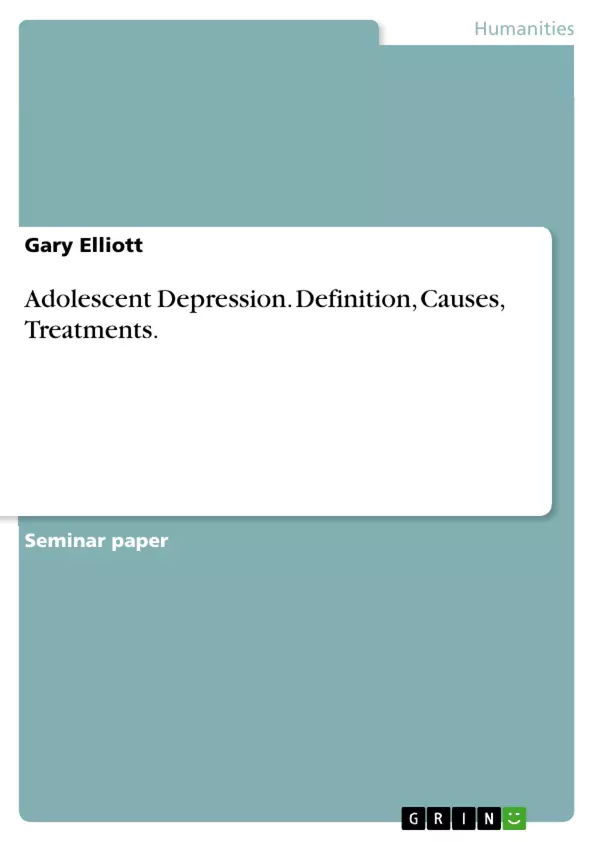As adults, when we think back to our childhood, many of us remember this period in our lives as a ‘happy’ time, free from the stresses and worries that accompany adulthood. The reality of the matter is that many children do experience stress and anxiety, similar to that of adults and this can, and often does result in children and adolescents in particular, experiencing mild to severe depression. According to Gerali (2009), depression is one of the most common issues that adolescents deal with and it affects teenagers regardless of their race, ethnicity, gender or socioeconomic status.
It is quite normal for peoples’ mood to change during the course of a day, and many experience mood changes from hour to hour, but when those moods become completely overwhelming and all consuming or fluctuate wildly, they may be indicative of some kind of mood disorder (McIntosh & Livingston, 2008). A depressed child will show characteristics similar to those of adults but there tends to be more self-blame, self-criticism and a generally poorer self-concept among teenagers who are experiencing depression (Jaenicke, Hammen, Zupan, Hiroto, Gordon, Adrian, & Burge , 1987).
Symptoms of depression begin to increase around the time of puberty and are characterized by intense feelings of sadness and worthlessness, accompanied by a sense of futility resulting in withdrawal from social situations (Sue, Sue & Sue, 1997; Berk, 2000).
During the course of this paper, I will focus on defining teenage depression, isolating the causes and predictive factors in conjunction with certain risk factors. Anxiety as a correlate of depression will be highlighted and two of the more common manifestations of depression, dysthymia and bipolar disorder will be outlined. Coexisting issues and the course of treatment will be addressed; ending with insight into suicide in adolescents. The point of departure needs to be a working concept of depression as it pertains to adolescents.
(a) Definition
Adolescence is defined as the period of development marked at the beginning by the onset of puberty and at the end by the attainment of physiological or psychological maturity. In Reber & Reber (2001), depression is defined in two categories: (1) Generally, a mood state characterized by a sense of inadequacy, a feeling of despondency, a decrease in activity or reactivity pessimism, sadness and related symptoms; (2) In Psychiatry...
Inhaltsverzeichnis (Table of Contents)
- What is childhood depression?
- Definition
- Prevalence
- Myths about Teenage Depression
- Theories
- Symptoms and Signs of Depression
- Causes of Depression
- Predictive Factors
- Defenses against Depression
- Risk Factors
- Anxiety Disorders and Depression
- Subtypes of Depression
- Dysthymia
- Bipolar Disorder
- Related Issues
- Treatments for Depression
- Psychotherapy
- Medication
- Alternate Medication
- Diet & Exercise
- Suicide
- Prevalence
- Reasons for Suicide
- Myths
- Warning Signs
- Ideation
- Sexuality
- Appendices
- Appendix A: DSM-IV-TR Criteria for Major Depressive Episode
- Appendix B: DSM-IV-TR Criteria for Generalized Anxiety Disorder
- Appendix C: DSM-IV-TR Criteria for Dysthymic Disorder
- References
Zielsetzung und Themenschwerpunkte (Objectives and Key Themes)
This paper aims to provide a comprehensive overview of adolescent depression. It focuses on defining the disorder, exploring its causes and predictive factors, and examining the role of anxiety. The paper further investigates the various subtypes of depression, including dysthymia and bipolar disorder. Treatment options and the issue of suicide in adolescents are also discussed.
- Definition and Prevalence of Adolescent Depression
- Causes and Risk Factors
- Anxiety and Depression
- Subtypes of Depression (Dysthymia and Bipolar Disorder)
- Treatment Options and Suicide
Zusammenfassung der Kapitel (Chapter Summaries)
The first chapter defines adolescent depression, drawing a distinction between general mood states and psychiatric classifications. It discusses the prevalence of depression, highlighting the growing concern regarding its impact on teenagers. Chapter two delves into the causes of depression, examining various factors that contribute to its development. The third chapter focuses on predictive factors, identifying elements that can indicate the likelihood of depression. Chapter four explores defenses against depression, suggesting strategies for coping with depressive symptoms. Chapter five discusses risk factors, highlighting potential vulnerabilities associated with depression. Chapter six examines the relationship between anxiety disorders and depression, exploring their interconnectedness. Chapter seven discusses subtypes of depression, focusing specifically on dysthymia and bipolar disorder. This chapter outlines the characteristics and distinctions between these two conditions.
Schlüsselwörter (Keywords)
Adolescent depression, mood disorders, dysthymia, bipolar disorder, anxiety disorders, risk factors, treatment options, suicide, DSM-IV-TR criteria.
- Quote paper
- Gary Elliott (Author), 2010, Adolescent Depression. Definition, Causes, Treatments., Munich, GRIN Verlag, https://www.grin.com/document/275086



